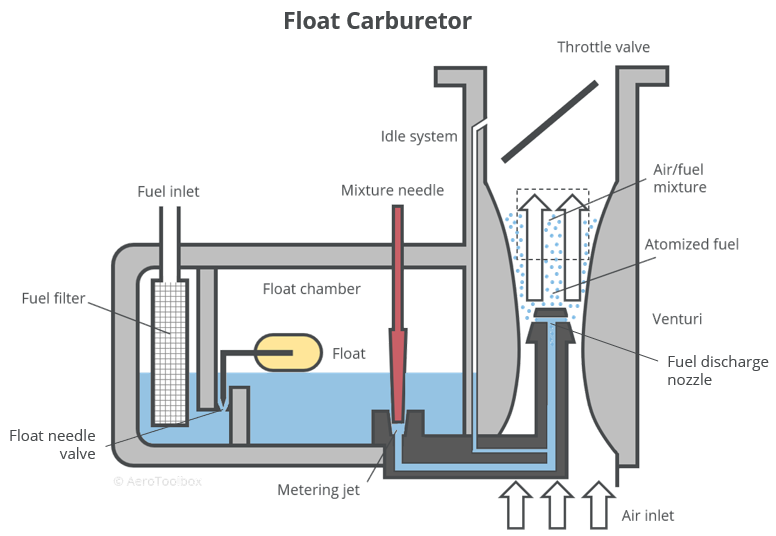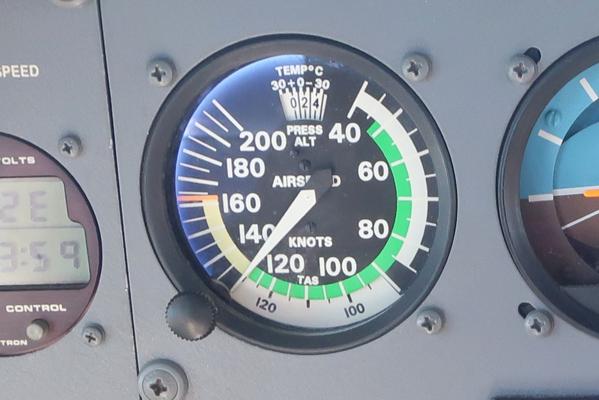Carburetor Design and Operation
A carburetor is the part of an engine’s induction system responsible for mixing the air and fuel. This mixture is then routed to each cylinder where it is ignited as part of the four-stroke engine cycle. Carburetors work on the principle of a venturi to atomize liquid fuel and mix it with air in the correct ratio for combustion to occur.
A sketch of a typical float carburetor is shown below. The throat of the carburetor corresponds to the narrowest section where the fuel discharge nozzle is located.

Refer to our extensive article on the design, operation and physics principles behind the carburetor for a more detailed discussion; here we'll simply discuss the reasons why carburetor icing occurs, and best practices from ensuring it doesn't happen to you when flying.
What Causes Carburetor Icing
A carburetor is still the most commonly used device in light aircraft to atomize and mix the fuel and air required for combustion, but is not without it drawbacks; principally a carburetor is susceptible to ice formation in the venturi portion of the device.
Any ice build-up will restrict the flow of the mixture to the engine which can result in a loss of engine power, and in extreme cases, an engine failure.
The venturi contraction results in an increase in velocity and corresponding decrease in pressure at the throat (narrowest region). This pressure drop results in a corresponding temperature drop in accordance with the ideal gas law.
The fuel discharge nozzle is located at the venturi throat where the atomized liquid fuel is introduced into the airflow and instantly vaporized. Energy is required to change the state of the fuel from a liquid to a gas. This energy is termed the latent heat of evaporation. The energy required to evaporate the fuel is extracted from the air passing through the throat which has the effect of decreasing the temperature in the throat even further.
The combination of the temperature drop as a result of the geometry of the venturi and the drop due to the latent heat required to vaporize the fuel can quite easily result in a situation where the temperature in the throat drops below freezing. If this happens then any moisture in the air entering the venturi may freeze and stick to the side of the venturi.
This type of icing is termed fuel evaporation icing and can take place in ambient temperatures as high as 100 °F (38°C) under the correct conditions of humidity. Icing is most likely to occur when temperatures are at or below 70°F (21°C) and relative humidity is above 80 %.
Carburetor Heat
Carburetor icing restricts the power output of the engine and so manifests as a loss in rpm in a fixed pitch propeller aircraft, and a loss in manifold pressure in an aircraft with a constant speed propeller. A rough running engine is another clear indication that icing may be a problem.
Carburetor icing is prevented or removed through the use of carburetor heat. This is an anti-icing system that ducts hot air into the venturi to keep the carburetor throat above freezing temperature. It can be used to melt ice that has already accumulated but is best used pre-emptively as a prevention measure.
How to Mitigate the Risk of Carburetor Icing
Use the calculator at the top of this page to quantify the risk of icing before your next flight.
Remember that carburetor icing can occur at temperatures as high as 38 ºC (100 ºF) and is most severe on days where the dew point and the air temperature are close together (high relative humidity).
It is best to refer to your aircraft's handbook for carb icing mitigation processes specific to your airplane make and model. That being said, there are a few common practices that you should follow to reduce the risk of carburetor icing.
- Prevention is better than cure. Most aircraft fitted with a carburetor heat lever in the cockpit. Be sure to use yours as described in your aircraft's POH. Remember that the application of carb heat results in a slight loss in power so don't forget to turn it off again on final approach once the runway is made in case you need to go around.
- Carburetor icing is most likely to occur at partial power settings. This is because of the cooling effect induced by a partially-closed throttle butterfly. However, referring to carburetor icing calculator you should appreciate that in certain atmospheric conditions, the risk of carburetor icing is high irrespective of the engine power setting.
- Always apply the carburetor heat fully. It is never a good idea to apply partial carburetor heat as this could cause the carburetor temperature to move into the icing temperature band.
For a more detailed look at the aircraft carburetor, the physics behind its operation, and the use of carb heat, you are encouraged to read through this detailed post.






